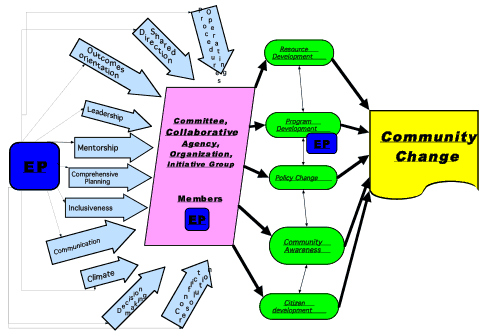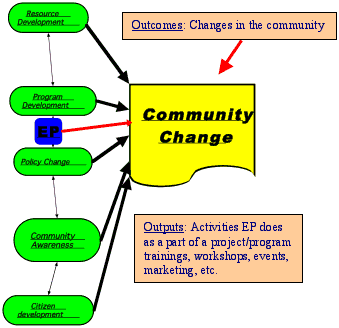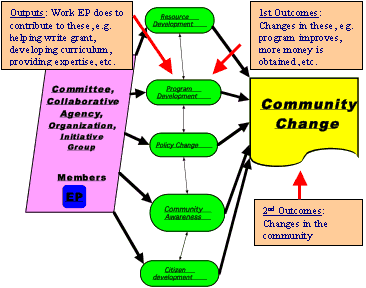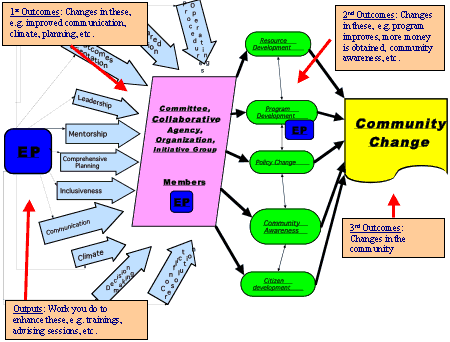April 2004 // Volume 42 // Number 2 // Tools of the Trade // 2TOT3
The Collaborative Community Change Model: Understanding and Evaluating University Extension Professionals' Role in Community Change
Abstract
The article presents a new model for understanding Extension
professionals' role in community change. This Collaborative Community
Change model incorporates aspects of effective collaborations
and the various influences that affect community change. It identifies different
points in the community change process where Extension professionals typically
contribute. Accordingly, it identifies indicators of activities that are
needed to achieve community-level change, depending on the point of contribution
within the model. The model is useful to Extension and community development
professionals who are involved in development and capacity-building activities
that lay the groundwork for community change outcomes.
Introduction
A central role of university Extension professionals is to provide research-based programming, technical expertise, and leadership in response to community needs. While some Extension professionals may provide discreet "direct service" programming (e.g., a series of water conservation trainings for community members), many assist by providing leadership or capacity building to a committee, initiative, or organization that is directly or indirectly affecting a community, statewide, or regional issue.
For example, an Extension professional who has a natural resource background may be asked to provide ongoing technical support for a wildlife conservation initiative. This initiative group might generate funds to enhance wildlife conservation areas and/or promote policy change. Another Extension professional might be asked to train members of a pregnancy prevention coalition on how to develop a sound strategic plan. This coalition might then work toward developing a marketing strategy to prevent teenage pregnancy.
University Extension professionals, in response to community needs, engage in various types of activities, which can be roughly categorized as: "direct service" programs, technical support, and capacity building. Each of these types of activities plays an important role in addressing the needs of communities. Nevertheless, many Extension professionals are challenged by how best to evaluate the impact of their technical support or capacity-building activities upon community change.
Collaborative Community Change Model
In response to a need expressed by faculty of the University of Nevada Cooperative Extension (UNCE) system, the authors developed a model that incorporated the complexity of Extension professionals' involvements in community change. The Collaborative Community Change model incorporates factors associated with effective collaborations and the various roles Extension professionals often play to address identified issues and influence community change.
Accordingly, it attempts to identify the various pathways that may influence community change, and helps to elucidate possible roles and activities that Extension faculty often play in trying to foster community change . Thus, the model can be used as a way to understand how to evaluate various capacity-building and community development activities that contribute to the success of individual and community developments.
Figure 1.
Collaborative Community Change Model*

* Portions adapted from Taylor-Powell, Rossing, & Gerran, (1998). Evaluating Collaboratives: Reaching the Potential. University of Wisconsin Cooperative Extension.
Each blue box (Extension Professional [EP]) represents a point in the community change process where an Extension professional might conduct programming. The furthest right blue box represents an Extension professional who designs and/or conducts a discreet program that directly works towards creating community change. For example, an Extension professional may be conducting a nutrition education program that seeks to prevent diabetes.
The middle right blue box represents an EP who serves on a committee who works toward developing a program, policy, or community awareness that can directly affect community change. For example, an EP may be serving on a collaborative committee and contributing to the development of a funding proposal that creates after school programs in a particular neighborhood. The long-term goal of these efforts is to reduce problem behavior among youth in the community.
The first blue box represents an EP who works to strengthen the functional capacity of a collaborative effort. For example, an EP may be conducting a series of trainings on leadership for a collaborative water conservation effort, or an EP may be facilitating meetings for a collaborative initiative on wildlife conservation and be working toward improving the inclusiveness and climate of the initiative group. This group may be working toward the development a wildness management plan that, in turn, will increase habitat and breeding of an endangered species.
Since many Extension systems throughout the United States have adopted the logic model as a program planning and evaluation paradigm, the logic model has been overlaid upon this Collaborative Community Change model to illustrate its application. Figures 2 through 4 include possible outputs and outcomes for various roles Extension professionals play in the community change process.
Figure 2.
Typical Direct Service Program

Figure 3.
Project or program improvement

Figure 4.
Organizational Capacity Building*

* Portions adapted from Taylor-Powell, Rossing, & Gerran, (1998). Evaluating Collaboratives: Reaching the Potential. University of Wisconsin Cooperative Extension.
Using the Model
Once an EP is able to place where his or her work in a particular area fits upon the model, the next step is to begin assessing that work's impact upon the sequence of processes that lead to community change. For example, if an EP is training an AIDS prevention organization with the intent to improve their communication and planning skills, the EP would begin by measuring if this work had indeed increased the quality of the organization's communication and planning. If the EP had a substantial amount of time and effort in this work, he or she might assess whether the organization was better able to generate an AIDS-prevention planning document and/or grant proposal as a result of the EP's work. Last, the EP could conduct an assessment to determine whether these documents had an impact on AIDS prevention at an individual and/or community level.
Clearly, it would not be valid to claim that trainings for a collaborative group resulted in community change, and the work should not be framed as such. Numerous authors have noted, however, that ineffective collaborative groups often cannot accomplish their long-term goals (Bunker & Rubin, 1995; Holman & Devane, 1999). Thus, effective group functioning is vital to a collaborative organization's ability to contribute to the process of community change. The work of improving how a collaborative group functions can be significant and the relative effectiveness, if feasible, should be assessed and documented.
Another limitation of this approach is that there are numerous immeasurable factors that contribute to group functioning and, indeed, community change. Nevertheless, the work that EPs do as a part of collaborative efforts, if significant, should be seen as one contributive factor and measured and documented as an indirect part of the community change process.
The model allows Extension professionals to place themselves in the community change process and view how their various capacity-building activities, if they are successful, contribute to community change. Once a program or individual identifies the appropriate point in the community change model, the model suggests important evaluation indicators. Thus, this model can be extremely useful to Extension and non-Extension professionals who are involved in evaluating programming efforts that "indirectly" lead to community change.
Acknowledgement
The article is a modified version developed from a presentation made at the American Evaluation Association's 2003 annual conference.
References
Bunker, B., & Rubin, J. (1995). Conflict, cooperation, & justice. San Francisco: Jossey-Bass Inc.
Holman P., & Devane, T. (1999). The change handbook: Group methods for shaping the future. San Francisco: Berrett-Koehler Publishers, Inc.
Taylor-Powell, E., Rossing, B., & Gerran, J. (1998). Evaluating collaboratives: Reaching the potential. University of Wisconsin Cooperative Extension.
